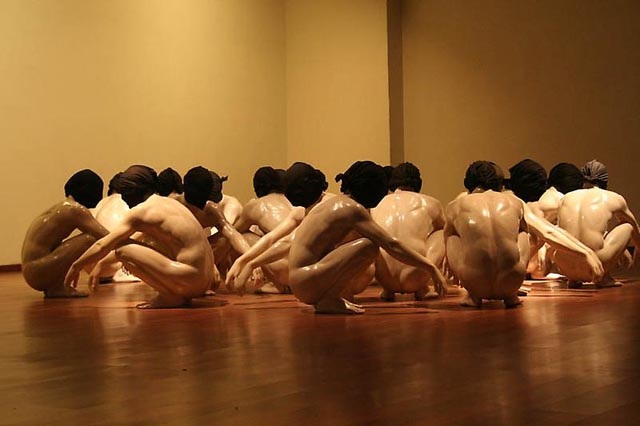
G. R. Iranna
THE DEAD SMILE
2007
Fiberglass and cloth
29 x 24 x 32 in. (24 Figures)
Contemporary Art from India and Pakistan
India and Pakistan may have been geographically birthed on the same subcontinent but they are relentlessly apart as nations. It is a question of so near – and yet so far. Once one people, they are now so far apart that can one understand the mindset of The Other?
Yet, art by Indian and Pakistani artists hung side by side in the Aicon Gallery in Manhattan – perhaps there were not even six degrees of separation between these canvases.
Looking at these powerful works of art one would be hard-pressed to say which artist was from India, and which from Pakistan. This only goes to prove that at heart, the dreams, the hopes and the fears are the same…
Aicon Gallery presented Reprise 2010, a group exhibition showcasing contemporary art from South Asia, and many of these artists had been featured earlier in the gallery’s two major contemporary group shows- Home and the World, and Malleable Memory. In recent years, Aicon has introduced many emerging artists from Pakistan to showcase the evolving contemporary art scene there.
The artists in Reprise 2010, which was organized by Andrew Shea, the associate gallery director, included Sana Arjumand, Ruby Chishti, John Jurayj, G. R. Iranna, Rehana Mangi, Jatinder Marwaha, Shoaib Mehmood, Nitin Mukul, Huma Mulji, Baiju Parthan, Debanjan Roy, Reena Saini Kallat, Attiya Shaukat, Anjali Srinivasan, Adeela Suleman, and Mahreen Zuberi.
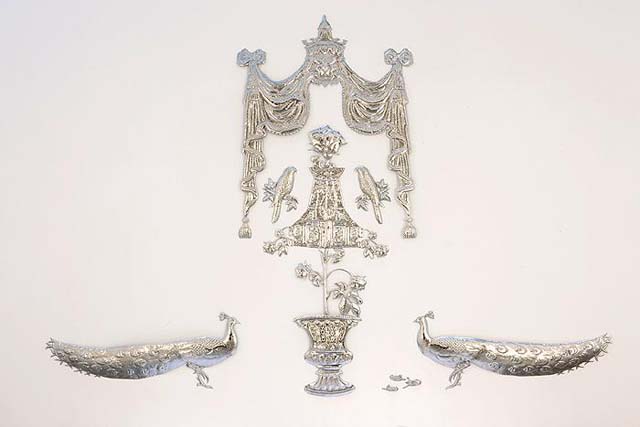
Adeela Suleman
UNTITLED 2 (Peacocks with Drapes) (Ed. of 3)
2010
Steel
102 x 140 in
“Over the last few years, we’ve been covering more and more of the contemporary arts from Pakistan,” said Kai Matsu of Aicon Gallery. “While this show is not the first time we’ve shown Indian and Pakistani art in the same show, Reprise 2010 may very well have been the most “mixed” in terms of the number of pieces represented by region over the recent years – nearly half of the works were in fact from Pakistan.”
Walking into the gallery, one got the sense of being on edge, of being surrounded. This is not restful art but art which speaks to our troubled times. You cannot escape ‘Dead Smile’ – GR Iranna’s powerful tableaux of condemned men taking up the whole floor – the feel is more of a prison than an art gallery. Seemed almost awkward and intrusive to be standing there, sipping wine and chatting with friends, so real was the discomfort of being next to this circle of the damned.
As Donald Kuspit wrote in the catalog of Iranna’s London show, “In what is clearly a tour de force of protest art, a masterpiece of social commentary, Iranna shows us the human truth of our times, shows us how far man has fallen: abject and anonymous, stripped naked and emasculated, his figures squat submissively, like dogs waiting to spring up and do their master’s bidding. They are lined up in rows, and – the crowning touch, brilliantly simple – their heads are shrouded in plastic, effectively muffling, even suffocating them : they dare not speak out, dare not protest their servitude, dare not stand head held high and proud.”
The sense of unease, of questioning the crumbling, out-of-control world around us seemed to touch many of the artworks. Pakistani artist Adeela Suleman’s fragile stainless steel works evoke an idyllic paradise of parrots and peacocks, flowers and foliage – yet look closer and you see juxtaposed with these are missiles and suicide jackets – and the stench of death is never very far away.
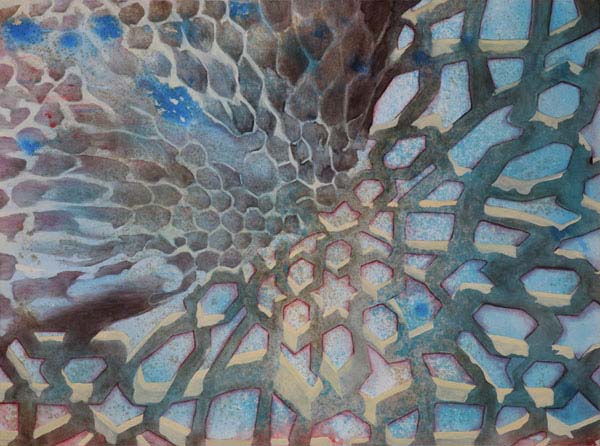
Nitin Mukul
MOSQUE NEST
2008
Oil, acrylic and tea stain on canvas
48 x 36 in.
Nitin Mukul, who is Indian-American, and with a foot in both worlds brings his own perspectives to his abstract canvases which are built on the myriads of photographs he shoots as the scaffolding for the final artwork. In the foreboding ‘Mosque-Nest’ he touches upon the demonizing of all Muslims that seems to have occurred in the wake of terrorist attacks in different parts of the world. As Alexander Keefe explains in his essay, “Behind the surface there are pressures more urgent than the weight of the sky: the artist is making a point here about the dangerous powers attributed to Muslims in the contemporary imagination, the easy bleed between reductive frameworks for the characterization of social groups and the ways we imagine our pests as dangerous, unwanted non-human others. The mosque-nest marks an intersection between biology, architecture, urban space and human history.”
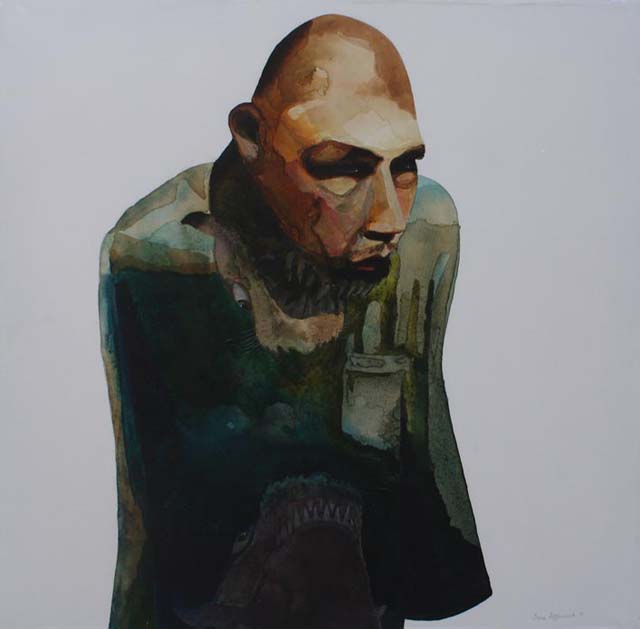
Sana Arjumand
THEN THEIR SHADOWS FELL FROM THE SKY 1
2010
Ink, acrylic and teas stains on canvas
36 x 36 in.
Sana Arjumand, who lives in Pakistan, paints surreal figures to explore ‘the set-up of society, social responsibility…confusion of identity, the role of religions vs. culture and the constant dilemma of being the ‘young, modern Pakistani female.’ Frequently employing symbolism, most notably elements from the Pakistani flag, to express notions such as national pride or political oppression, her work expresses the artist’s dual response towards her Pakistani identity: her pride and belief in her nationality and cultural heritage twinned with a desire to embrace the modern world, and her frustration with those whose actions and ideas might hinder this.”
As terrorism infiltrates our everyday world, it is a universal concern. Brooklyn-based artist John Jurayj, who is neither from India or Pakistan, addresses this in his powerful works done in oil and gunpowder. Be it the destroyed Twin Towers, suicide bombers or the quick dismemberment of normal lives, normal routines, these have become facts of life in the real world and in the world of art.
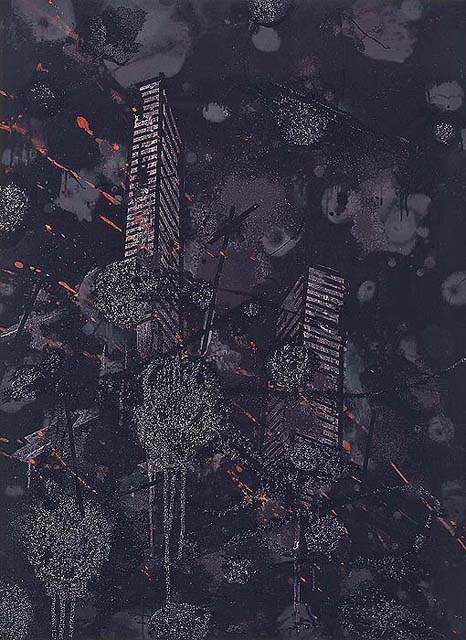
John Jurayj
UNTITLED (MIRROR IMAGE #34)
2010
Oil and gunpowder on black plexiglass
48 x 36 in.
This was art that brought into the open issues of terrorism and fundamentalism, of identity and loss of hope. The modern dance performance of Mariko Reynolds choreographed to the mournful Okinawan funeral music played by violinist Leyna Papach, was somber, a bit surreal and in sync with the mood. The young downtown crowd seemed to love it all as they buzzed around, viewed the art and socialized, in the midst of death and destruction.
Living on the edge is the only way to live, it seems, in these frenetic times.
Related Articles:
Painting Pakistan
Pakistani Artists’ Art from the Heart
Ayesha Durrani’s Women
